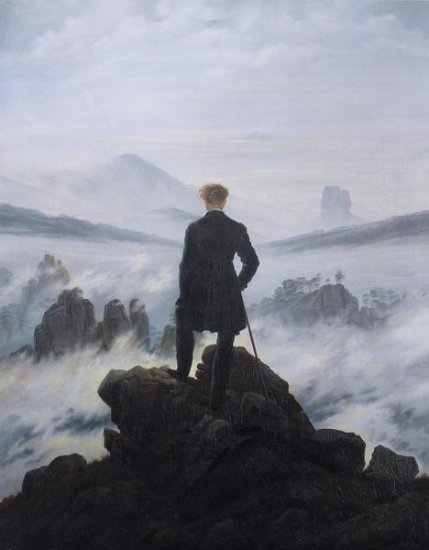Romanticism
Wanderer Above the Sea of Fog (1818) by Caspar David Friedrich (1774-1840) is widely considered to be a masterpiece of the Romantic Era. Romanticism was an artistic and literary movement that originated near the end of the 18th century. Its focus was subjectivity, imagination and one’s emotional response to the world. In essence it was an alternative to the Age of Enlightenment and industrialization. Romanticism stressed:
- a reverence towards nature
- looking to the past as a nobler era
- fascination with all things mysterious and exotic
- celebration of the heroic
Romanticists favored individualism in which freedom of action is preferable to group controls . They argued that passion and intuition were needed to understand the world and beauty was something that should evoke a strong emotional response.
The Man on the Mountain
In Friedrich’s painting we see a hiker standing on a peak high up in a mountain range. He looks down on the fog below. Since we only see him from the back, we have to wonder what is going through his mind. Art historians have speculated that the hiker is the artist himself. The only thing we know for sure is that we have no idea what he is thinking about. He might be admiring nature, or considering his place in the universe or his own mortality. He could be thinking about this view from a religious perspective. We simply do not know. And perhaps that is exactly what Caspar David Friedrich intended.
One of the interesting facts about this (and many other Friedrich paintings) is that the specific location of this vista does not actually exist. It is in fact a compilation assembled from many sources that Friedrich used when creating his landscapes. These include his own sketches along with pictures and sketches of faraway places that were provided by friends.1 The huge mountains in this painting might be Alps but for the fact that he never went there. All his mountaineering was in Germany, mostly close to Dresden. Furthermore, Friedrich was not a plein air painter. He might make various sketches on his hikes but ultimately “composed” his paintings in his studio.
Rückenfigur
Another interesting feature of Wanderer Above the Sea of Fog is the use of ruckenfigur. Rückenfigur refers to paintings in which persons in the foreground are seen from behind. It is a technique that Friedrich used extensively. It invites the viewer to take the place of the person in the painting thereby experiencing the landscape from the same perspective. By using this technique, Friedrich is encouraging us to contemplate this scene rather than trying to guess what is going through the mind of the hiker.
Caspar David Friedrich’s Legacy
Casper David Friedrich (1774-1880) was considered the most important landscape painter of his day. A major force in the 19th German Romantic movement, he is best known for his landscapes which often feature individuals seemingly lost in their own thoughts. Towards the latter part of his life his art fell from favor and he died in relative obscurity. There was a renewed interest in his work at the start of the 20th century some of which connected to the rise of Nazism. With the defeat of Germany in 1945 his work again fell out of favor because this association with German nationalism. However by 1970 his art began to be shown again in major international exhibitions. Today Caspar David Friedrich has a well established international reputation and is considered a cultural icon in Germany.
- The Magic of Silence by Florian Illies, Polity Press, Cambridge, UK. ISBN-13: 978-1-5095-6754-6


